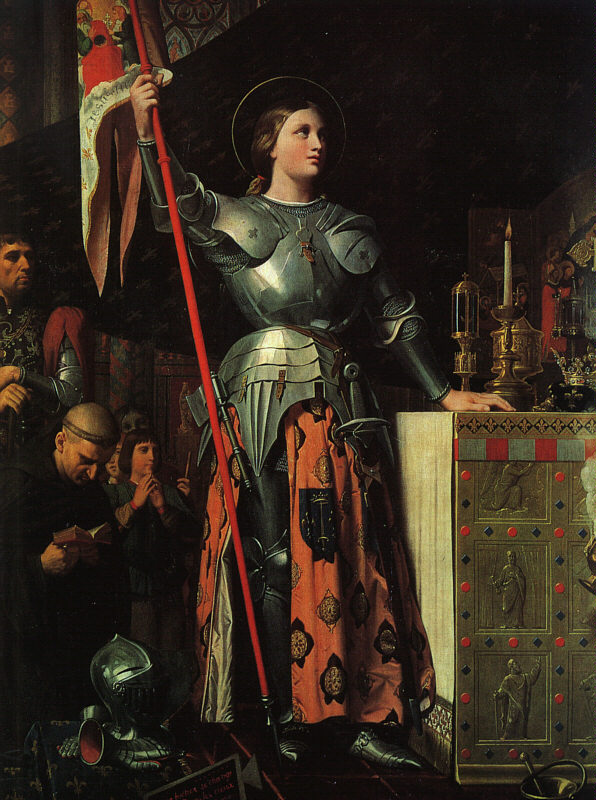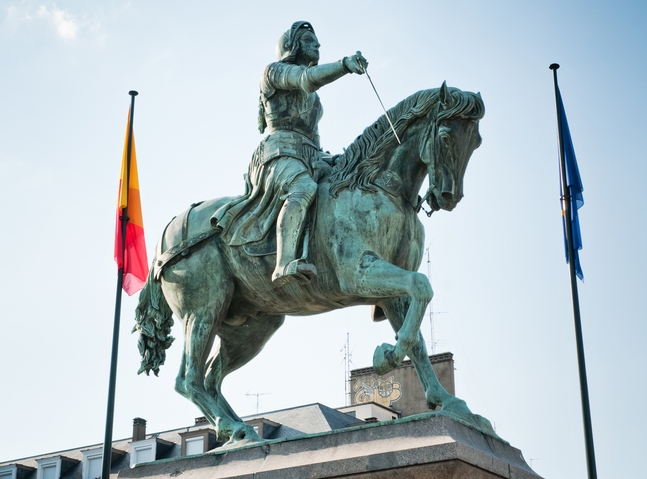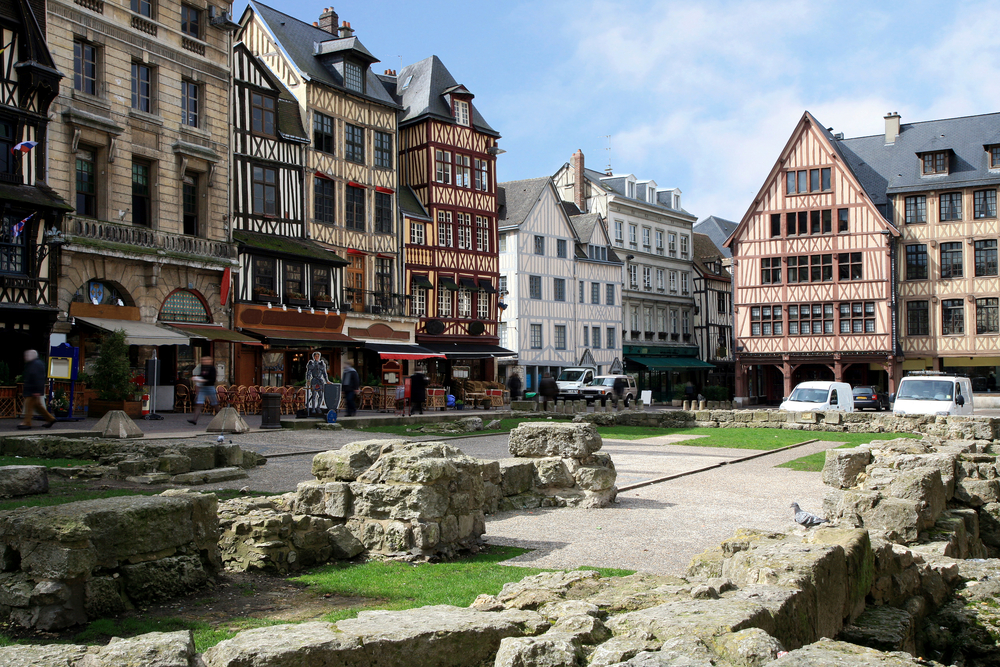Joan of Arc: Facts & Biography
Joan of Arc is the modern-day name of a teenage woman who, driven by voices she heard, fought to drive the English out of France and crown Charles VII as the French king.
Although we know her as Joan of Arc, or Jeanne d'Arc in French, she called herself Jehanne la Pucelle, or Joan the Maid. She is also known as the "Maid of Orléans." Pucelle means “maid” and also signifies that she was a virgin, an important distinction given that her society held female virginity before marriage in high regard.
Her military career lasted from between April 1429, when she left with troops to help raise the siege of Orléans, and May 1430 when she was captured by troops loyal to John of Luxembourg. She was subsequently handed over to forces loyal to English King Henry VI and after a trial she was condemned and burned at the stake in May 1431. At her trial, Joan said that she thought her age was 19.
She lived at a time when France was divided among Charles VII, who ruled south of the Loire River; Henry VI, the English boy-king who ruled much of northern France; and the Duchy of Burgundy, which controlled a rump of territory and was allied with the English.
The father of Henry VI had defeated the French at the Battle of Agincourt in 1415, a defeat that eventually led Charles VII’s father to agree to a treaty that allowed the French crown to pass to the English after his death. Charles VII refused to recognize this treaty and continued resistance albeit as an uncrowned ruler.
Although Joan’s military career was brief, and scholars debate the degree of control she had over the campaigns she was in, she raised French morale and her time in action was one that saw a recovery in French military fortunes, which ultimately allowed Charles VII to be crowned King of France.
Her reputation was such that the English, led in France by the regent John, Duke of Bedford, blamed their defeats on her alleged supernatural powers. “A disciple and limb of the Fiend, called the Pucelle, that used false enchantment and sorcery,” is how he described her in a report.
Get the world’s most fascinating discoveries delivered straight to your inbox.
To Joan and her supporters, her mission of driving the English out of France and crowning Charles was one that was called upon her by God. “I am sent here in God’s name, the King of Heaven, to drive you body for body out of all France...” she said in a challenge written down and sent to the English before she went into battle at Orléans.
Modern-day medical doctors have speculated that she may have suffered from a medical condition, such as schizophrenia or a form of epilepsy, which made her hear voices.
A world where children fought children
She was born in the village of Domrémy (now called Domrémy-la-Pucelle in her honor) in either 1412 or 1413. At the time she lived, it was a settlement on the border between France and the Holy Roman Empire.
It was also a place of conflicting loyalties. While the people of the village were generally loyal to Charles VII, many of the nearby territories were loyal to the Duchy of Burgundy, which was allied with the English. As Joan said at her trial, the place where she grew up was one where children literally fought children, some of them coming back “wounded and blooded.”
Her mother’s name was Isabelle Romee, and there are conflicting accounts as to the spelling of her father’s name. Researcher Nora Heimann notes in her book "Joan of Arc in French Art and Culture" (Ashgate Publishing, 2005) that her father’s name has been recorded with various spellings, including “Jacob d’Arc,” “Jaqes d’Arc,” “Jacques Tarc” and “Jacques Darc.”
While the last name “Arc” is what she is called today Joan didn’t use that name on campaign, preferring to be called “la Pucelle.” She started hearing voices at the age of 13, recounting at her trial that the first time she heard them was in her family’s garden. “The voice came from the right, from the direction of the church, and was accompanied by a bright light,” she said. The ringing of church bells would sometimes trigger them.
In 1428, her village was attacked by Anglo-Burgundian forces and her family fled, returning after the attack was over. After this, she left home for the last time, going to Vaucouleurs and eventually persuading a reluctant local official named Robert de Baudricourt to give her an escort to take her to see Charles VII at his castle at Chinon.
Siobhan Nash-Marshall, now a professor at Manhattanville College, writes in her book "Joan of Arc: A Spiritual Biography" (Crossroad Publishing, 1999) that the journey was more than 300 miles (480 kilometers), taking them through territory controlled by the enemy and bandits. Traveling by night, avoiding towns, and at times going through the wilderness they reached the castle.
Persuading Charles
One of history’s great mysteries is how a teenage girl hearing voices and claiming to be on a mission from God persuaded Charles VII (at the time in his 20s) to give her soldiers and send her to help raise the siege of Orléans.
“We will never know what happened at Chinon. It is one the abiding mysteries of history,” writes Marina Warner, a professor at the University of Essex, in her book "Joan of Arc: The Image of Female Heroism" (Oxford University Press, 2013). Warner notes that at her trial, Joan asked not to be pressed on what happened at Chinon, and when questioned said that Charles received a sign, of some form, to signify that her story was true.
“Go boldly! For when you stand before the king, he will have a sign [that will make him] receive you and believe in you,” her voices told her. After her meeting with Charles, she was sent to Poitiers to be questioned about her experiences, and subsequently was given a squire, a page and some soldiers and sent with a force to relieve Orléans.
Warner points out that, contrary to popular belief, Joan was not in command of this force. Rather, the force was led by the Count of Dunois. Ignoring Joan’s advice, the count sneaked around the English fortifications, trying to get his force, loaded with equipment and provisions, into Orléans without a major battle. “This infuriated Joan, who was clearly eager to get on with her mission,” Nash-Marshall writes.
Joan succeeded in making a believer out of the count when he found his force stranded beside a riverbank, unable to bring supplies to Orléans across barges because the wind was against him.
She told the count that “I am bringing you better help than ever you got from any soldier or any city. It is the help of the King of Heaven.” The count later claimed that at that moment the wind changed direction, allowing his force and supplies to cross into Orléans.
Nash-Marshall points out that, when in Orléans, she provided a morale boost to the civilians and soldiers there. Even though the French now outnumbered their besiegers, their commanders were reluctant to attack the Anglo-Burgundian forces until more help arrived. Joan pressed for an assault, and eventually an attack was launched against the most isolated of the enemy fortifications to the east.
Joan provided another boost during the battle, when she “arrived at the scene, it is claimed, a roar went up among the French troops, who redoubled their efforts and won the day with ease,” writes Nash-Marshall. With French confidence growing, the soldiers attacked one besieging fort after another, eventually breaking the siege of the city.
Nash-Marshall points out that the morale boost Joan gave cannot be underestimated. “French morale was so low before Joan appeared that the [French] even lost those battles in which they outnumbered the Anglo-Burgundians on a massive scale. More often than not, they simply preferred to stay off the battlefield.”
A king crowned
With Orléans saved, and subsequent French campaigns succeeding in liberating towns on the Loire River, Joan was now in a position to fulfill a major part of her God-given mission — the crowning of Charles VII as King of France.
French kings were crowned at Reims, a city that at the time was under control of the Anglo-Burgundians. Despite it being behind enemy lines, Joan begged Charles to go, and the king eventually set off with a party that encountered surprisingly little resistance, actually gaining the support of several towns held by the enemy on the way.
When they arrived in Reims, they held the ceremony as quickly as possible, with Charles being knighted, anointed and crowned as best as could be done under the circumstances.
Joan said at her trial that she embraced the newly crowned king at his knees and said “gentle king, now is executed the will of God, who wished that the siege of Orléans should be lifted, and that you should be brought into this city of Reims to receive your holy consecration, thus showing that you are a true king, and he to whom the kingdom of France should belong.”
The ceremony took place on July 17, 1429, and, although Joan didn’t know it, this would represent the height of her military achievements.
An aggressive Joan and a diplomatic king
With momentum on the newly crowned king’s side, there was pressure on him to march on Paris, the capital of France, and reclaim it. Joan, along with other commanders, pushed for this, but the king was hesitant. Nash-Marshall pointed out that the king actually agreed to a 15-day truce with his enemies, a mere ruse, as it turned out, to give them time to fortify Paris.
When the attack on Paris finally happened, the king was hesitant to commit the bulk of his forces to it and it ultimately failed. Furthermore, it happened on Sept. 8, the birthday of the Virgin Mary, something that hurt Joan’s image as no fighting was supposed to take place on this holy day.
Joan’s ambitions to drive the English out of the rest of France only went downhill from there. The king made a truce with the Burgundians, the allies of the English, which was to last until Christmas. Furthermore, before winter set in, Charles VII disbanded his army.
Never again would Joan’s efforts receive support from the king, who appeared more determined to pursue diplomacy and consolidate his gains. On Dec. 29, Joan and her family were ennobled; something which Nash-Marshall points out gave her the right to attack the English without the king’s permission. “Charles' gesture was a courteous but unmistakable farewell,” Nash-Marshall writes.
Capture, trial and execution
Without the backing of the king, Joan was unable to launch any more major attacks. In May 1430, an Anglo-Burgundian force laid siege to the town of Compiègne and Joan, with no more than a few hundred men, rushed to its aid. Her voices had told her a few months before that she would soon be captured by the English but she went to the town’s defense anyways.
The Anglo-Burgundian force was far larger than her own and she tried to aid the town’s defenders by launching hit-and-run attacks to keep the enemy off balance. On May 23 one of these attacks failed, the enemy having sufficient warning to give chase to her much smaller force. Although most of her soldiers managed to escape back to the town walls, Joan herself was captured by troops loyal to John, the Duke of Luxembourg.
This marked the end of her military career and the beginning of her captivity. Although Joan had sympathizers among the Duke’s family, and John was originally reluctant to hand her over to the English, he was eventually paid 10,000 livres to turn her over, an immense amount of money at the time. Pierre Cauchon, a bishop who supported the English and pushed for her arrest, remarked that although it was a king’s ransom “certainly the capture of this woman in no way resembles the capture of a king, or princes, or other persons of high rank.”
When Joan learned she was to be turned over to the English, she threw herself off a tower, apparently in an attempt to commit suicide. She survived her attempt and was brought to Rouen to face trial.
The verdict was never in doubt. “Her side saw her as a holy virgin, her enemies as a polluted sorceress,” Warner said. She was interrogated thoroughly, the Anglo-Burgundians tried to discredit her by questioning her virginity and linking her to magic. Even her wearing of men’s clothes was used against her, her prosecutors claiming that it was against the natural order of things. [Related: Medieval Justice Not So Medieval]
Her trial and interrogations went on through the first four months of 1431. During that time Charles VII, the French king whom she had helped crown, made no attempt to get her back through ransom or prisoner exchange. “This suggests, hard as it may seem, that Charles and his advisers were disillusioned enough to tolerate her condemnation as a heretic,” Warner writes.
On May 30, 1431, she was led to the stake. “When Joan of Arc went to the stake, she wore over her shaven head a tall mitre like a dunce’s cap. On the cap, the words of her crimes were inscribed in Latin, for her shame and the dread of the onlookers,” writes Nash-Marshall. In a nutshell she was labelled “heretical, relapsed, apostate and idolatrous.”
As the fire was lit, and spread, she uttered her last words, “Jesus! Jesus! Jesus,” she said, repeating Christ’s name several times before her death.
Canonization
In the century to follow, the English lost control over their remaining French territories. Calais, the last English territory in France, fell in 1558. Joan’s name was formally rehabilitated in an inquiry during the 1450s, and in 1920 she was made a saint of the Catholic Church.
The New York Times reported that her canonization ceremony at St. Peter’s Basilica in Rome attracted “60,000 to 70,000 persons” and “was the greatest and most impressive function performed in the historic basilica not only by the present Pontiff but for several centuries past.”
— Owen Jarus, LiveScience Contributor

Owen Jarus is a regular contributor to Live Science who writes about archaeology and humans' past. He has also written for The Independent (UK), The Canadian Press (CP) and The Associated Press (AP), among others. Owen has a bachelor of arts degree from the University of Toronto and a journalism degree from Ryerson University.



